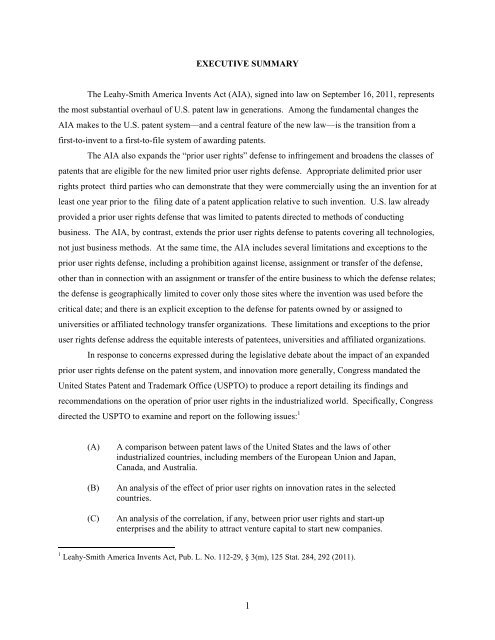Prior User Rights Study Report to Congress - America Invents Act
Prior User Rights Study Report to Congress - America Invents Act
Prior User Rights Study Report to Congress - America Invents Act
You also want an ePaper? Increase the reach of your titles
YUMPU automatically turns print PDFs into web optimized ePapers that Google loves.
EXECUTIVE SUMMARYThe Leahy-Smith <strong>America</strong> <strong>Invents</strong> <strong>Act</strong> (AIA), signed in<strong>to</strong> law on September 16, 2011, representsthe most substantial overhaul of U.S. patent law in generations. Among the fundamental changes theAIA makes <strong>to</strong> the U.S. patent system—and a central feature of the new law—is the transition from afirst-<strong>to</strong>-invent <strong>to</strong> a first-<strong>to</strong>-file system of awarding patents.The AIA also expands the “prior user rights” defense <strong>to</strong> infringement and broadens the classes ofpatents that are eligible for the new limited prior user rights defense. Appropriate delimited prior userrights protect third parties who can demonstrate that they were commercially using the an invention for atleast one year prior <strong>to</strong> the filing date of a patent application relative <strong>to</strong> such invention. U.S. law alreadyprovided a prior user rights defense that was limited <strong>to</strong> patents directed <strong>to</strong> methods of conductingbusiness. The AIA, by contrast, extends the prior user rights defense <strong>to</strong> patents covering all technologies,not just business methods. At the same time, the AIA includes several limitations and exceptions <strong>to</strong> theprior user rights defense, including a prohibition against license, assignment or transfer of the defense,other than in connection with an assignment or transfer of the entire business <strong>to</strong> which the defense relates;the defense is geographically limited <strong>to</strong> cover only those sites where the invention was used before thecritical date; and there is an explicit exception <strong>to</strong> the defense for patents owned by or assigned <strong>to</strong>universities or affiliated technology transfer organizations. These limitations and exceptions <strong>to</strong> the prioruser rights defense address the equitable interests of patentees, universities and affiliated organizations.In response <strong>to</strong> concerns expressed during the legislative debate about the impact of an expandedprior user rights defense on the patent system, and innovation more generally, <strong>Congress</strong> mandated theUnited States Patent and Trademark Office (USPTO) <strong>to</strong> produce a report detailing its findings andrecommendations on the operation of prior user rights in the industrialized world. Specifically, <strong>Congress</strong>directed the USPTO <strong>to</strong> examine and report on the following issues: 1(A)(B)(C)A comparison between patent laws of the United States and the laws of otherindustrialized countries, including members of the European Union and Japan,Canada, and Australia.An analysis of the effect of prior user rights on innovation rates in the selectedcountries.An analysis of the correlation, if any, between prior user rights and start-upenterprises and the ability <strong>to</strong> attract venture capital <strong>to</strong> start new companies.1 Leahy-Smith <strong>America</strong> <strong>Invents</strong> <strong>Act</strong>, Pub. L. No. 112-29, § 3(m), 125 Stat. 284, 292 (2011).1


